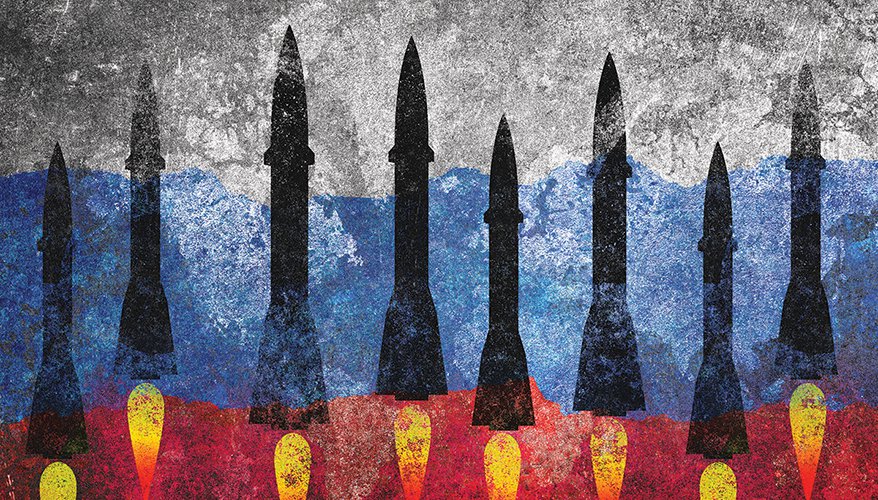Resurgent Russia Poses Challenges to NATO

iStock illustration
This spring, Army Gen. Christopher Cavoli, commander of European Command, provided sobering testimony during the annual congressional posture season.
Russia’s nuclear forces have been unaffected by its illegal invasion of Ukraine, and the authoritarian regime still retains the largest arsenal of both deployed and non-deployed nuclear weapons in the world, he said.
Furthermore, Russia also continues to modernize its nuclear forces and to pursue development of nuclear-capable intercontinental ballistic missile systems, nuclear-armed hypersonic boost-glide vehicles, nuclear-powered cruise missiles and underwater drones, anti-satellite weapons and orbital nuclear weapons, he noted.
Cavoli also emphasized that the invasion of Ukraine has not impacted the capacity of Russia’s strategic forces, long-range aviation, cyber capabilities, space capabilities or its capabilities in the electromagnetic spectrum.
The invasion of Ukraine was not just a violation of international law. It is a brutal conflict involving the whole of Ukrainian society, and the reported atrocities against combatants and non-combatants have shocked the complacency modern Western societies have developed over the last several decades regarding the brutal realities of total war.
But there is a deeper complacency out of which collectively the United States and its allies and partners must be shocked. Russia is reconstituting its forces faster than initial estimates, and it is on track to command the largest military on the European continent with a defense industrial base capable of generating substantial amounts of ammunition and materiel in support of large-scale combat operations, testimony revealed.
This is a credible security challenge. From the regime’s perspective, Russia is fighting for the soul of its national identity and to reverse the psychological insecurity of having Ukraine and other territories outside its historic perimeter defenses.
It is worth directly quoting Cavoli’s testimony: “Regardless of the outcome of the war in Ukraine, Russia will be larger, more lethal and angrier with the West than when it invaded.”
This is crucially important context for why at the 2023 Vilnius Summit, NATO approved new regional plans. This is part of a larger political and military strategy that reflects that the center of gravity of the operational level of warfare on the European continent is increasingly shifting eastward. This also explains why NATO agreed at the 2016 Warsaw Summit to enhanced forward presence to improve deterrence in Northern, Central and Eastern Europe.
It is also important context for why policymakers pay serious attention to Russian military doctrine, which emphasizes the use of all available systems across multiple operational domains, including the information and cyber domains, and a combination of defensive and offensive capabilities to achieve the objective of degrading an adversary’s capabilities and prevailing in conflict through attrition.
Russian military strategy therefore emphasizes countering adversaries’ command, control, communications, computers, intelligence, surveillance and reconnaissance capabilities and has a high tolerance for protracted conflict.
To counter this challenge, NATO members continue to underscore the need to maintain the defensive alliance’s technological competitive edge and to modernize and expand its current forces and capabilities.
A significant area of focus requiring urgent attention is to accelerate operationalizing NATO members’ repeated commitment to use the alliance structure as a standards setter and requirements setter for these capabilities.
For example, the new regional plans will require a revision of NATO’s command-and-control architecture. One illustrative example frequently cited in publicly available sourcing is the need to fully integrate the alliance’s various air defense systems. Policymakers, as well as military leaders and planners, are fully aware the evolving character of warfare requires a modern, integrated air and missile defense architecture with sufficient capacity and qualitative capability, including networked sensors, to counter threat systems at all altitudes and across all operational domains.
While this has been a longstanding area of concern, Russia’s exploitation of the proliferation of inexpensive, long-range attack uncrewed aerial systems has added urgency to this capacity and capability challenge.
However, without renewed energy to modernize and political will to fund NATO’s command-and-control air defense infrastructure to create a web of sensors and interceptors, the status quo of procuring disparate systems is not just operationally irrelevant but a waste of funding.
NATO has a real opportunity to be both the requirements aggregator and the delivery enabler to promote sustainable and effective defense industrial capacity to meet the moment of increased air defense threats. This will require addressing capability gaps, severely limited interoperability and platform survivability. It will also require addressing deficiencies in enabling capabilities such as artificial intelligence tools, data architecture, space and cyber capabilities, intelligence processing and communications systems, as well as their supporting services. It will also require a deeper look at the investment needed to recruit and retain the right personnel and to ensure personnel have sufficient training.
In its 2024 report on the readiness and resilience of the U.S. defense industrial base, the National Defense Industrial Association highlighted the importance of successfully managing time, funding and shared risk in restoring the capacity and capability of industry to be resilient in an era of great power competition.
As policymakers, business leaders and interested citizens — on both sides of the Atlantic Ocean — think about the future of collective deterrence against revisionist powers, successfully managing these three values — time, funding and shared risk — is critical as the NATO alliance evolves to meet a rapidly changing strategic and operational environment. ND
Jennifer Stewart is executive vice president of strategy and policy at NDIA.
Topics: International


Comments (0)